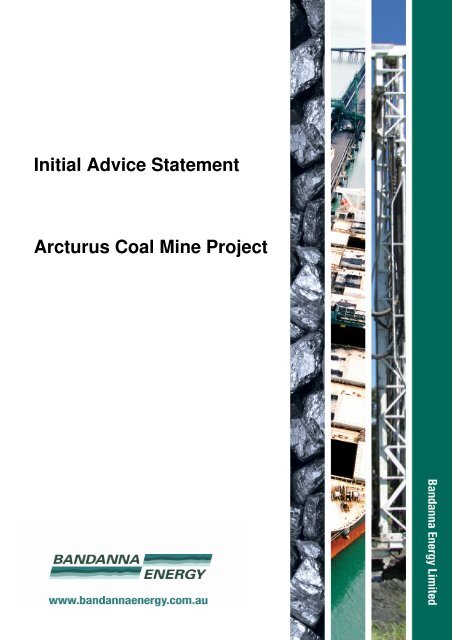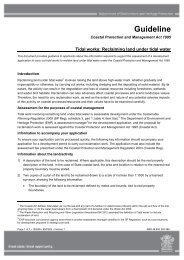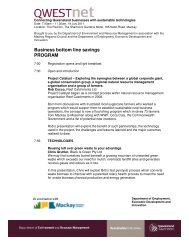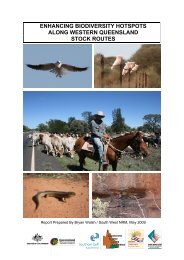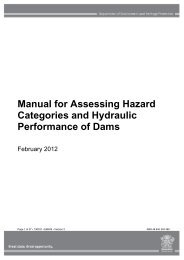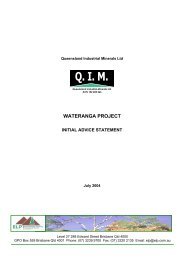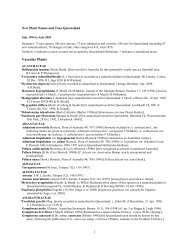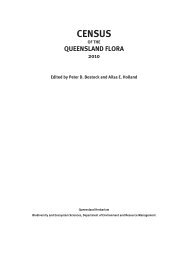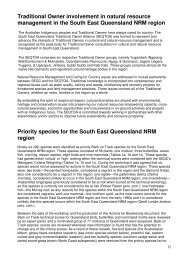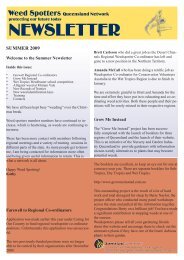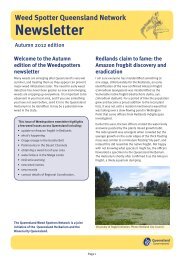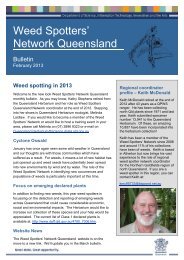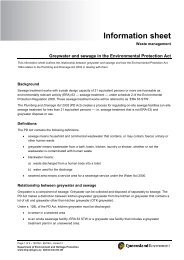Initial Advice Statement for the Arcturus Coal Mine Project
Initial Advice Statement for the Arcturus Coal Mine Project
Initial Advice Statement for the Arcturus Coal Mine Project
Create successful ePaper yourself
Turn your PDF publications into a flip-book with our unique Google optimized e-Paper software.
<strong>Initial</strong> <strong>Advice</strong> <strong>Statement</strong><br />
<strong>Arcturus</strong> <strong>Coal</strong> <strong>Mine</strong> <strong>Project</strong>
INITIAL ADVICE STATEMENT<br />
ARCTURUS COAL MINE PROJECT<br />
Table of Contents<br />
1. Introduction .................................................................................................... 1<br />
1.1 Background ................................................................................................................................ 1<br />
1.2 Proponent .................................................................................................................................. 1<br />
1.3 <strong>Project</strong> Assessment .................................................................................................................... 1<br />
1.4 Purpose of <strong>the</strong> <strong>Initial</strong> <strong>Advice</strong> <strong>Statement</strong> .................................................................................... 1<br />
2. <strong>Project</strong> Description .......................................................................................... 3<br />
2.1 The Resource .............................................................................................................................. 3<br />
2.2 Land Tenure ............................................................................................................................... 3<br />
2.3 Mining Process ........................................................................................................................... 5<br />
2.3.1 Underground <strong>Mine</strong> ............................................................................................................... 5<br />
2.3.2 Open Cut <strong>Mine</strong> ..................................................................................................................... 5<br />
2.4 <strong>Coal</strong> Handling and Preparation Plant ......................................................................................... 5<br />
2.5 Infrastructure Requirements...................................................................................................... 6<br />
2.6 <strong>Project</strong> Access ............................................................................................................................ 6<br />
2.7 Post <strong>Mine</strong> Rehabilitation ............................................................................................................ 7<br />
2.8 <strong>Project</strong> Approvals ....................................................................................................................... 7<br />
2.9 Work<strong>for</strong>ce .................................................................................................................................. 7<br />
2.10 Native Title ................................................................................................................................. 7<br />
2.11 Affected and Interested parties ................................................................................................. 7<br />
3. Existing Environment and Potential Impacts .................................................... 8<br />
3.1 Climate ....................................................................................................................................... 8<br />
3.2 Land Resources .......................................................................................................................... 8<br />
3.2.1 Soils....................................................................................................................................... 8<br />
3.2.2 Topography ........................................................................................................................ 10<br />
3.2.3 Land Suitability ................................................................................................................... 10<br />
3.3 Water Resources ...................................................................................................................... 10<br />
3.3.1 Surface Water ..................................................................................................................... 10<br />
3.3.2 Groundwater ...................................................................................................................... 11<br />
3.4 Nature Conservation ................................................................................................................ 13<br />
3.4.1 Regional Ecosystems .......................................................................................................... 13<br />
3.4.2 Flora .................................................................................................................................... 15<br />
3.4.3 Fauna .................................................................................................................................. 15<br />
3.5 Noise ........................................................................................................................................ 16<br />
3.6 Air Quality ................................................................................................................................ 16<br />
24-Nov-10<br />
P a g e | i<br />
2010
INITIAL ADVICE STATEMENT<br />
ARCTURUS COAL MINE PROJECT<br />
3.7 Waste Management ................................................................................................................. 16<br />
3.8 Safety and Health ..................................................................................................................... 17<br />
3.9 European and Cultural Heritage ............................................................................................... 17<br />
3.10 Socio – Economics .................................................................................................................... 17<br />
3.11 Traffic and Transportation ....................................................................................................... 17<br />
4. Stakeholder Engagement ............................................................................... 19<br />
5. References .................................................................................................... 20<br />
List of Tables<br />
Table 1. Regional Ecosystems present within EPC 1221 ...................................................................................... 13<br />
Table 2. Potential EPBC Act listed rare and threatened flora that may occur in EPC 1221 ................................. 15<br />
Table 3. Potential EPBC Act listed rare and threatened fauna that may occur in EPC 1221 ............................... 15<br />
List of Figures<br />
Figure 1. <strong>Project</strong> Location ...................................................................................................................................... 2<br />
Figure 2. Stratigraphic Column <strong>for</strong> <strong>the</strong> <strong>Arcturus</strong> Deposit. ..................................................................................... 3<br />
Figure 3. EPC 1221 <strong>Arcturus</strong> – Land tenure ........................................................................................................... 4<br />
Figure 4. EPC 1221 <strong>Arcturus</strong> - Soils ........................................................................................................................ 9<br />
Figure 5. EPC 1221 <strong>Arcturus</strong> - Hydrology ............................................................................................................. 12<br />
Figure 6. EPC 1221 <strong>Arcturus</strong> - Regional Ecosystems ............................................................................................ 14<br />
24-Nov-10<br />
P a g e | ii<br />
2010
INITIAL ADVICE STATEMENT<br />
ARCTURUS COAL MINE PROJECT<br />
1. INTRODUCTION<br />
1.1 Background<br />
Springsure Creek <strong>Coal</strong> Pty Ltd (<strong>the</strong> Proponent) proposes to develop <strong>the</strong> <strong>Arcturus</strong> <strong>Coal</strong> <strong>Mine</strong> (<strong>the</strong> <strong>Project</strong>). The<br />
<strong>Project</strong> site is located approximately 40 km south of Emerald and approximately 60 km to <strong>the</strong> southwest of <strong>the</strong><br />
township of Blackwater (see Figure 1).<br />
The <strong>Project</strong> involves <strong>the</strong> development and operation of a new open cut and underground mine and associated<br />
infrastructure to produce up to 5 million tonnes per annum (Mtpa) of run-of-mine (ROM) coal. The <strong>Project</strong> is<br />
expected to commence in construction 2012 and continue <strong>for</strong> approximately 30 years.<br />
1.2 Proponent<br />
The <strong>Project</strong> will be developed and operated by Springsure Creek <strong>Coal</strong> Pty Ltd, a wholly owned subsidiary of<br />
Bandanna Energy. Bandanna Energy is an Australian owned public company which listed on <strong>the</strong> Australian<br />
Securities Exchange’s in 2008. Bandanna Energy has a market capitalisation of A$514 million as at 18<br />
November 2010. Bandanna Energy has been in operation since 2008 and has over 1,300 million tonnes of<br />
JORC compliant Resources and Reserves.<br />
The contact details <strong>for</strong> Springsure Creek <strong>Coal</strong> are:<br />
Springsure Creek <strong>Coal</strong><br />
Level 12, 410 Queen Street<br />
Brisbane Qld 4000.<br />
1.3 <strong>Project</strong> Assessment<br />
The Proponent will seek to have <strong>the</strong> <strong>Project</strong> assessed through an Environmental Impact <strong>Statement</strong> (EIS)<br />
prepared under Chapter 3 of <strong>the</strong> Environmental Protection Act 1994 (EP Act). This IAS is submitted in support<br />
of <strong>the</strong> Proponents application to prepare a Voluntary EIS in accordance with section 71 of <strong>the</strong> EP Act.<br />
A referral under <strong>the</strong> Environment Protection and Biodiversity Conservation 1999 (EPBC Act) will be made to <strong>the</strong><br />
Commonwealth Department of Sustainability, Environment, Water, Population and Communities (DSEWPC) to<br />
determine if <strong>the</strong>re are any controlling provisions <strong>for</strong> <strong>the</strong> project. A review of <strong>the</strong> EPBC Act Significant Impact<br />
threshold triggers has been undertaken and it is assessed <strong>the</strong> project may impact Matters of National<br />
Environmental Significance. As such it is expected <strong>the</strong> project will be declared a “controlled action” and<br />
<strong>the</strong>re<strong>for</strong>e approval <strong>for</strong> <strong>the</strong> project will be required from <strong>the</strong> Commonwealth.<br />
Should <strong>the</strong> project be declared a controlled action, it is expected <strong>the</strong> project will be assessed using an<br />
accredited environmental assessment process under <strong>the</strong> EP Act in accordance with <strong>the</strong> bilateral agreement<br />
between <strong>the</strong> Australian and Queensland governments. Terms of Reference (ToR) <strong>for</strong> <strong>the</strong> EIS will be developed<br />
based on <strong>the</strong> outcomes of this IAS and <strong>the</strong> requirements of relevant Commonwealth and State government<br />
agencies and submissions of stakeholders and <strong>the</strong> community.<br />
1.4 Purpose of <strong>the</strong> <strong>Initial</strong> <strong>Advice</strong> <strong>Statement</strong><br />
The purpose of this <strong>Initial</strong> <strong>Advice</strong> <strong>Statement</strong> (IAS) is to provide sufficient in<strong>for</strong>mation to:<br />
• <strong>the</strong> Queensland Government Department of Environment and Resource Management (DERM) to<br />
assess <strong>the</strong> Proponent’s application to prepare a voluntary EIS <strong>for</strong> <strong>the</strong> <strong>Project</strong>; and<br />
• <strong>the</strong> Commonwealth DEWPC to assist with <strong>the</strong> assessment of <strong>the</strong> <strong>Project</strong> Referral Application pursuant<br />
to <strong>the</strong> requirements of <strong>the</strong> EPBC Act.<br />
24-Nov-10<br />
P a g e | 1<br />
2010
INITIAL ADVICE STATEMENT<br />
ARCTURUS COAL MINE PROJECT<br />
Figure 1. <strong>Project</strong> Location<br />
24-Nov-10<br />
P a g e | 2<br />
2010
INITIAL ADVICE STATEMENT<br />
ARCTURUS COAL MINE PROJECT<br />
2. PROJECT DESCRIPTION<br />
2.1 The Resource<br />
The <strong>Arcturus</strong> deposit is part of <strong>the</strong> northwest trending Denison Trough. The trough lies along <strong>the</strong> western<br />
margin of <strong>the</strong> Bowen Basin and comprises coal seams within <strong>the</strong> Bandanna Formation, <strong>the</strong> correlative<br />
equivalent to <strong>the</strong> Rangal <strong>Coal</strong> Measures to <strong>the</strong> north and east.<br />
Con<strong>for</strong>mably overlain by <strong>the</strong> Triassic Rewan Formation, <strong>the</strong> Bandanna Formation contains up to seven coal<br />
seams within <strong>the</strong> area (see Figure 2). The overlying Rewan Formation is generally capped with Tertiary basalts,<br />
unconsolidated sands and or clays.<br />
The tenement is characterized by a series of broad, en echelon anticlines, shallowly dipping to <strong>the</strong> east and<br />
west, and bound to <strong>the</strong> nor<strong>the</strong>ast and southwest by regionally extensive basement faults. The primary targets<br />
<strong>for</strong> exploration within <strong>the</strong> tenement are in <strong>the</strong> areas proximal to <strong>the</strong>se anticlines.<br />
Springsure Creek <strong>Coal</strong> has to date identified total resources of 206.3 million tonnes including 103.7 million<br />
tonnes of INFERRED RESOURCE and 102.6 million tonnes of INDICATED RESOURCE within EPC 1221.<br />
Additionally 44.3 million tonnes of marketable reserve has been identified.<br />
Figure 2. Stratigraphic Column <strong>for</strong> <strong>the</strong> <strong>Arcturus</strong> Deposit.<br />
2.2 Land Tenure<br />
The <strong>Project</strong> is located approximately 40 km south of Emerald and approximately 60 km to southwest of<br />
Blackwater, in <strong>the</strong> Bowen Basin central Queensland and consists of Exploration Permit <strong>Coal</strong> (EPC) 1221. EPC<br />
1221 occurs on 55 separate allotments as shown at Figure 3.<br />
EPC 1221 lies within <strong>the</strong> Central Highlands Regional Council Local Government area.<br />
24-Nov-10<br />
P a g e | 3<br />
2010
INITIAL ADVICE STATEMENT<br />
ARCTURUS COAL MINE PROJECT<br />
Figure 3. EPC 1221 <strong>Arcturus</strong> – Land tenure<br />
24-Nov-10<br />
P a g e | 4<br />
2010
INITIAL ADVICE STATEMENT<br />
ARCTURUS COAL MINE PROJECT<br />
The proponent is currently planning to submit a Mining Lease Application (MLA) pursuant to <strong>the</strong> requirements<br />
of <strong>the</strong> <strong>Mine</strong>ral Resources Act 1989, and Voluntary EIS and draft Environmental Authority (mining lease)<br />
(EA(ml)) pursuant to <strong>the</strong> EP Act in Q2 2011. The proponent will commence negotiations with <strong>the</strong> property<br />
owners <strong>for</strong> acquisition of <strong>the</strong> properties within <strong>the</strong> project area on submission of <strong>the</strong> MLA.<br />
2.3 Mining Process<br />
The <strong>Project</strong> involves <strong>the</strong> development of a new underground coal mine, open cut coal mine and associated<br />
infrastructure. The current mine plan is based on construction commencing in 2012, with first production to<br />
commence in 2013 after a construction and development period of 12 months. A production rate of 5 Mtpa is<br />
currently planned <strong>for</strong> <strong>the</strong> first phase of <strong>the</strong> mine development; however, future expansion may occur<br />
dependent on favourable exploration results.<br />
2.3.1 Underground <strong>Mine</strong><br />
The proponent is currently evaluating a range of methods to establish <strong>the</strong> most cost effective and efficient<br />
design <strong>for</strong> <strong>the</strong> underground mine and resource extraction process as part of feasibility assessment currently in<br />
progress.<br />
Current planning to date indicates <strong>the</strong> proposed operation will use underground longwall operations;<br />
however, fur<strong>the</strong>r development of <strong>the</strong> mine plan may include <strong>the</strong> use of board and pillar methods. <strong>Coal</strong> will be<br />
delivered to <strong>the</strong> surface via conveyors and <strong>the</strong>n transferred to a raw coal stock pile. A ventilation system <strong>for</strong><br />
<strong>the</strong> underground mine using shafts and tunnels will be incorporated into <strong>the</strong> design.<br />
2.3.2 Open Cut <strong>Mine</strong><br />
The open cut mining method is planned to be a strip mining operation with waste removal by truck-excavator<br />
with dozer assist. Although <strong>the</strong> deposit is suitable <strong>for</strong> a dragline, it is not currently planned to utilise one. The<br />
truck-excavator fleets will remove waste while parting material will be place in-pit where possible or short<br />
dumped to regrade coal haulage ramps.<br />
<strong>Coal</strong> is planned to be mined by loaders or excavators into rear dump trucks and hauled up traditional spoil side<br />
ramps to <strong>the</strong> ROM crushing and handling facility.<br />
The final open cut strip will provide access <strong>for</strong> <strong>the</strong> underground operation. The tertiary material will generally<br />
excavated without blasting; however, all o<strong>the</strong>r overburden will most likely be drilled and blasted prior to<br />
removal.<br />
2.4 <strong>Coal</strong> Handling and Preparation Plant<br />
The Proponent has, at this stage, determined that <strong>the</strong> ROM coal <strong>for</strong>thcoming from both <strong>the</strong> open cut and<br />
underground mine components would be subject to a simple crushing and screening process and delivered to<br />
market as a raw product. Should <strong>the</strong> market change to require a higher quality product <strong>the</strong>n a “washed”<br />
product may be considered.<br />
If <strong>the</strong>n, <strong>the</strong> <strong>Project</strong> requires <strong>the</strong> construction of a <strong>Coal</strong> Handling and Preparation Plan (CHPP) and a co-disposal<br />
facility onsite. The CHPP would include a ROM coal delivery system and pad, coal washery module, coal waste<br />
delivery system, product coal delivery system and stockpiles. The CHPP would be designed to support <strong>the</strong><br />
initial 5 Mtpa; however, <strong>the</strong> modularisation would allow <strong>for</strong> future optimisation of <strong>the</strong> CHPP to accommodate<br />
higher throughput volumes.<br />
Typically ROM coal would be dumped on a ROM pad and pushed by ei<strong>the</strong>r dozer or front end loader into a<br />
feeder as part of <strong>the</strong> delivery system. The ROM coal would <strong>the</strong>n be crushed in three stages and fed to <strong>the</strong><br />
24-Nov-10<br />
P a g e | 5<br />
2010
INITIAL ADVICE STATEMENT<br />
ARCTURUS COAL MINE PROJECT<br />
CHPP at a 40 mm top size. The CHPP is comprised of a dense medium cyclone and a spiral circuit with <strong>the</strong> fines<br />
(
INITIAL ADVICE STATEMENT<br />
ARCTURUS COAL MINE PROJECT<br />
2.7 Post <strong>Mine</strong> Rehabilitation<br />
Rehabilitation, decommissioning and closure activities will be part of <strong>the</strong> overall rehabilitation strategy <strong>for</strong> <strong>the</strong><br />
<strong>Arcturus</strong> <strong>Project</strong>. The objectives outlined in <strong>the</strong> EA(ml) and EM Plan <strong>for</strong> <strong>the</strong> <strong>Project</strong> will be complied with<br />
during <strong>the</strong> progressive rehabilitation of <strong>the</strong> site. Typical strategies that will be incorporated into <strong>the</strong> final<br />
rehabilitation plan include:<br />
• land<strong>for</strong>m designs <strong>for</strong> out of pit dumps, co-disposal facilities and final voids;<br />
• subsidence management;<br />
• revegetation and landscape restoration programs and monitoring consistent with <strong>the</strong> requirements<br />
<strong>for</strong> strategic cropping land; and<br />
• annual review of disturbance footprint and liability.<br />
2.8 <strong>Project</strong> Approvals<br />
The proponent is seeking to have <strong>the</strong> MLA approved by <strong>the</strong> Queensland Department of Employment,<br />
Economic Development and Innovation (DEEDI) under <strong>the</strong> MR Act, and <strong>the</strong> EA(ml) approved by DERM under<br />
<strong>the</strong> EP Act. The proponent is seeking to have <strong>the</strong> project assessed via a Voluntary EIS and approval under <strong>the</strong><br />
EPBC Act is expected to be required.<br />
Separate approvals / agreements will be required from <strong>the</strong> relevant authorities <strong>for</strong> <strong>the</strong> connection onto <strong>the</strong><br />
Rolleston and Blackwater rail systems, and from <strong>the</strong> relevant authorities <strong>for</strong> <strong>the</strong> power and water supply<br />
connections.<br />
In addition to <strong>the</strong> EA(ml) it is likely that approval <strong>for</strong> <strong>the</strong> following environmentally relevant activities (ERA) will<br />
be required <strong>for</strong> <strong>the</strong> project:<br />
• ERA8 – Chemical Storage;<br />
• ERA56 – Regulated Waste Storage; and<br />
• ERA63 – Sewage Treatment.<br />
2.9 Work<strong>for</strong>ce<br />
The <strong>Project</strong> is expected to employ 300 employees during construction and 150 employees during operations.<br />
Employees will likely comprise of a mixture of local personnel and contractors. A fly-in / fly-out contingent<br />
may be necessary where vacancies cannot be filled by local personnel.<br />
2.10 Native Title<br />
Native Title is extinguished over <strong>the</strong> subject land.<br />
The Registered Cultural Heritage Body <strong>for</strong> <strong>the</strong> area is <strong>the</strong> Yumba Burin Heritage Association Inc..<br />
2.11 Affected and Interested parties<br />
In accordance with <strong>the</strong> requirements of <strong>the</strong> EP Act, Interested and Affected Person have been identified and<br />
<strong>the</strong>ir contact details have been provided to DERM with <strong>the</strong> application <strong>for</strong> assessment via Voluntary EIS.<br />
24-Nov-10<br />
P a g e | 7<br />
2010
INITIAL ADVICE STATEMENT<br />
ARCTURUS COAL MINE PROJECT<br />
3. EXISTING ENVIRONMENT AND POTENTIAL<br />
IMPACTS<br />
Technical studies on <strong>the</strong> environmental aspects (e.g. water, soils, flora and fauna etc) of <strong>the</strong> project will be<br />
undertaken through <strong>the</strong> preparation of <strong>the</strong> voluntary EIS. These assessments will be used to identify <strong>the</strong><br />
environmental values of <strong>the</strong> project area and <strong>the</strong> potential impacts on those values as a consequence of <strong>the</strong><br />
construction and operation of <strong>the</strong> proposed <strong>Project</strong>. The following sections summarises <strong>the</strong> receiving<br />
environment within <strong>the</strong> proposed study area.<br />
3.1 Climate<br />
The mean temperature range is between 6.2 o and 34.2 o with <strong>the</strong> coldest month being June and <strong>the</strong> hottest<br />
being December. The Rainfall in <strong>the</strong> Springsure region is variable, with most rainfall in <strong>the</strong> warmer months.<br />
On average, most of <strong>the</strong> annual rainfall is received between December and March. Rainfall is lowest between<br />
June and September (Bureau of Meteorology Comet street, Springsure: Site number 035065). Winds occur<br />
predominantly from <strong>the</strong> east during spring and summer, often between 21-30 km/h (data collected from <strong>the</strong><br />
Comet street, Springsure Station). These continue through to mid autumn and in late autumn are generally<br />
more south easterly. The cooler, drier air is characteristic of <strong>the</strong> dominant sou<strong>the</strong>ast winds of moderate<br />
strength, usually with long calm periods in <strong>the</strong> winter.<br />
3.2 Land Resources<br />
3.2.1 Soils<br />
The geology of <strong>the</strong> <strong>Arcturus</strong> EPC is dominated by basalt, conglomerate sandstone and clay, soil, sand and<br />
gravel. The predominant mapped soil types within <strong>the</strong> EPC are Vertosols, also known as cracking clays or Black<br />
Earths. Chromosols are also present in distinct bands running west to east through <strong>the</strong> EPC with small patches<br />
of Sodosols in <strong>the</strong> far western sections (see Figure 4).<br />
Vertosols are soils that exhibit shrink / swell characteristics and strong cracking when dry. Vertosols are highly<br />
productive soils which require very little cultivation due to <strong>the</strong> soils’ self cracking / mulching characteristics.<br />
Vertosols most commonly exist in areas with flat to slightly undulating topography and are often derived from<br />
alluvium and o<strong>the</strong>r sedimentary deposits as is likely to be <strong>the</strong> case within <strong>the</strong> EPC.<br />
Chromosols are soils with a clear or abrupt textural B horizon where <strong>the</strong> major half of <strong>the</strong> B2 horizon is not<br />
strongly acid and non-sodic. These soils may have favourable physical and chemical properties but many now<br />
have hardsetting surface layers with structural degradation caused by long-term cultivation. Chromosols are<br />
generally associated with Riverine plains as <strong>the</strong>y appear to be in this region.<br />
Sodosols are soils with a strong texture contrast between <strong>the</strong> A horizon and sodic B horizon within <strong>the</strong> soil<br />
profile. The B horizon is <strong>the</strong> layer of soil within a soil profile with characteristics different to <strong>the</strong> surface layer<br />
(A Horizon). An abrupt textural change occurs at <strong>the</strong> B horizon in which most of <strong>the</strong> upper part of <strong>the</strong> B2<br />
horizon is sodic and not strongly acidic. Sodosols have a high percentage of exchangeable sodium and are<br />
prone to dispersion and erosion. These soils are predominantly red, brown, yellow, grey or black in <strong>the</strong> B<br />
horizon and may have hardpans or calcrete. Sodosols also exist in predominantly flat to undulating<br />
topography and on alluvial and colluvial sediments.<br />
Mapped landscape units present within <strong>the</strong> EPC indicate gentle to moderate undulating plains with occasional<br />
higher stony ridges or broad hill crests. The dominant soils associated with this landscape are shallow to<br />
moderately deep dark clays often with linear gilgai on micro-relief on slopes. Deeper clays exist in lower lying<br />
sections, level plains or narrow stream flood plains. On higher stony ridges shallow uni<strong>for</strong>m clays occur.<br />
24-Nov-10<br />
P a g e | 8<br />
2010
INITIAL ADVICE STATEMENT<br />
ARCTURUS COAL MINE PROJECT<br />
Figure 4. EPC 1221 <strong>Arcturus</strong> - Soils<br />
24-Nov-10<br />
P a g e | 9<br />
2010
INITIAL ADVICE STATEMENT<br />
ARCTURUS COAL MINE PROJECT<br />
3.2.2 Topography<br />
The topography of <strong>the</strong> <strong>Arcturus</strong> mine lease area is dominated by a flat to gently undulating alluvial fan<br />
associated with outwash from <strong>the</strong> Sandhurst, Sirius, and Orion Creeks. West of <strong>the</strong> proposed mine site <strong>the</strong><br />
topography changes dramatically associated with <strong>the</strong> Great Dividing Range.<br />
Subsidence can lead to changes in <strong>the</strong> landscape appearance within <strong>the</strong> impact zone above longwall activities.<br />
As such <strong>the</strong> proponent will undertake a detailed assessment of potential impacts associated with subsidence<br />
as part of <strong>the</strong> EIS. Subsidence typically occurs over <strong>the</strong> mined section of <strong>the</strong> longwall panels and can result in<br />
an undulating or corrugated surficial appearance. The extent to which subsidence affects <strong>the</strong> land surface is<br />
driven by factors such as <strong>the</strong> width and thickness of <strong>the</strong> coal seams being mined, <strong>the</strong> thickness and physical<br />
attributes of <strong>the</strong> overlying strata and <strong>the</strong> number and timeframe of <strong>the</strong> mined coal seams.<br />
The results of <strong>the</strong> detailed assessment will be used to better understand potential impacts from subsidence<br />
and to develop a range of mitigation measures to return <strong>the</strong> site to <strong>the</strong> previous land uses (i.e. cropping).<br />
Options associated with rehabilitation of subsidence areas will also be assessed during <strong>the</strong> detailed studies and<br />
modeling. Final mitigation strategies will be included in <strong>the</strong> Post Mining Rehabilitation Plan.<br />
3.2.3 Land Suitability<br />
The <strong>Arcturus</strong> mine is located within an area mapped as “strategic cropping land” under <strong>the</strong> framework policy -<br />
Protecting Queensland’s strategic cropping land: A policy framework. The area within EPC 1221 that <strong>the</strong><br />
Mining Lease will be sought has historically been used <strong>for</strong> cropping purposes. Land disturbed by <strong>the</strong> project<br />
will be returned to agriculture where practical. Notable exceptions of disturbance categories that will not be<br />
returned to agriculture include voids, dams, co-disposal emplacements and remaining infrastructure such as<br />
buildings. A comprehensive land suitability survey will be conducted during <strong>the</strong> mine planning studies to<br />
confirm pre-disturbance land condition. The mine and infrastructure will be designed with <strong>the</strong> intent to<br />
minimizing <strong>the</strong> extent of cropping land that is disturbed to <strong>the</strong> point that it cannot be returned to <strong>the</strong> predisturbance<br />
use.<br />
3.3 Water Resources<br />
3.3.1 Surface Water<br />
The <strong>Project</strong> area is located in a significant contributing catchment area of approximately 14,000km² which is<br />
predominately associated with <strong>the</strong> Comet River. The project area and contributing catchments are located in<br />
<strong>the</strong> Central Highlands Regional Council Local Government area in Queensland, and have a number of waterway<br />
systems intersecting <strong>the</strong> subject areas, all of which flow to <strong>the</strong> Fitzroy River Basin. Waterways intersecting <strong>the</strong><br />
tenements are shown at Figure 5 and include:<br />
• Comet River;<br />
• Orion Creek;<br />
• Wyanda Creek;<br />
• Satellite Creek;<br />
• Station Creek;<br />
• Springsure Creek;<br />
• Turkey Creek;<br />
• Nine Mile Creek; and<br />
24-Nov-10<br />
P a g e | 10<br />
2010
INITIAL ADVICE STATEMENT<br />
ARCTURUS COAL MINE PROJECT<br />
• <strong>Mine</strong>rva Creek.<br />
All <strong>the</strong> major and minor waterways influencing <strong>the</strong> <strong>Project</strong> area are described as non-perennial and <strong>the</strong>re<strong>for</strong>e<br />
flow only during intense periods of rainfall. The typical land use in <strong>the</strong>se catchment areas is described as<br />
production from relatively natural environments, production from dry land agriculture, with some areas of<br />
conservation and natural environments.<br />
The minimum elevation at <strong>the</strong> catchment outlet is approximately 140 m with an average slope through <strong>the</strong><br />
majority of <strong>the</strong> mid to lower catchment of 0.53%. Steeper catchments located in <strong>the</strong> upper highlands are<br />
shown to have catchment slopes of approximately 0.90%.<br />
3.3.2 Groundwater<br />
The <strong>Project</strong> is located within <strong>the</strong> Bowen Basin in Central Queensland. The groundwater flow directions within<br />
<strong>the</strong> Bowen basin are likely to loosely follow topographic gradients and generally flow from west to east. The<br />
aquifer lithology underlying <strong>the</strong> area is dominated by basic volcanic and sedimentary strata including<br />
sandstone, shale, and conglomerates. Bore yields are typically low (
INITIAL ADVICE STATEMENT<br />
ARCTURUS COAL MINE PROJECT<br />
Figure 5. EPC 1221 <strong>Arcturus</strong> - Hydrology<br />
24-Nov-10<br />
P a g e | 12<br />
2010
INITIAL ADVICE STATEMENT<br />
ARCTURUS COAL MINE PROJECT<br />
3.4 Nature Conservation<br />
3.4.1 Regional Ecosystems<br />
A substantial portion of <strong>the</strong> proposed mining lease area has been cleared <strong>for</strong> agricultural purposes. Remnant<br />
vegetation exists along <strong>the</strong> riparian areas and continues to exist in areas less suited to agriculture. A list of<br />
Regional Ecosystems present at EPC 1221 and <strong>the</strong>ir current conservation status are listed in Table 1 and shown<br />
at Figure 6.<br />
Table 1. Regional Ecosystems present within EPC 1221<br />
RE Code Description Conservation Status 1 Biodiversity<br />
Status<br />
11.3.1 Acacia harpophylla and / or<br />
Casuarina cristata open <strong>for</strong>est on<br />
alluvial plains<br />
11.3.3 Eucalyptus coolabah woodland<br />
on alluvial plains<br />
11.3.4 Eucalyptus tereticornis and / or<br />
Eucalyptus spp. tall woodland on<br />
alluvial plains<br />
11.3.6 Eucalyptus melanophloia<br />
woodland on alluvial plains<br />
11.4.3 Acacia harpophylla and/or<br />
Casuarina cristata shrubby open<br />
<strong>for</strong>est on Cainozoic clay plains<br />
11.4.9 Acacia harpophylla shrubby open<br />
<strong>for</strong>est to woodland with<br />
Terminalia oblongata on<br />
Cainozoic clay plains<br />
11.8.5 Eucalyptus orgadophila open<br />
woodland on Cainozoic igneous<br />
rocks<br />
11.8.11 Dichanthium sericeum grassland<br />
on Cainozoic igneous rocks<br />
11.9.5 Acacia harpophylla and / or<br />
Casuarina cristata open <strong>for</strong>est on<br />
fine-grained sedimentary rocks<br />
1. Status under <strong>the</strong> Vegetation Management Act 1999<br />
2. Status under <strong>the</strong> EPBC Act<br />
Conservation<br />
Status 2<br />
Endangered Endangered Threatened<br />
Of Concern Of Concern N/A<br />
Of Concern Of Concern N/A<br />
Least Concern Of Concern N/A<br />
Endangered Endangered Threatened<br />
Endangered Endangered Threatened<br />
Least Concern No Concern N/A<br />
Of Concern Of Concern N/A<br />
Endangered Endangered Threatened<br />
24-Nov-10<br />
P a g e | 13<br />
2010
INITIAL ADVICE STATEMENT<br />
ARCTURUS COAL MINE PROJECT<br />
Figure 6. EPC 1221 <strong>Arcturus</strong> - Regional Ecosystems<br />
24-Nov-10<br />
P a g e | 14<br />
2010
INITIAL ADVICE STATEMENT<br />
ARCTURUS COAL MINE PROJECT<br />
3.4.2 Flora<br />
A detailed floristic survey will be undertaken as part of <strong>the</strong> EIS to assess <strong>the</strong> site <strong>for</strong> species listed under <strong>the</strong><br />
Nature Conservation Act 1992 (NC Act) and <strong>the</strong> EPBC Act. Rare and threatened species listed under <strong>the</strong> EPBC<br />
Act that potentially occur within <strong>the</strong> <strong>Project</strong> area and <strong>the</strong>ir conservation status are shown in Table 2.<br />
Table 2. Potential EPBC Act listed rare and threatened flora that may occur in EPC 1221<br />
Scientific Name Common Name Conservation<br />
Status<br />
Likelihood of Occurrence<br />
Aristida annua A grass Sp. Vulnerable Species or species habitat likely to<br />
occur within area<br />
Cadellia pentastylis Ooline Vulnerable Species or species habitat likely to<br />
occur within area<br />
3.4.3 Fauna<br />
A detailed fauna survey will be undertaken as part of <strong>the</strong> EIS to assess <strong>the</strong> site <strong>for</strong> species listed under <strong>the</strong> NC<br />
Act and <strong>the</strong> EPBC Act. Rare and threatened species listed under <strong>the</strong> EPBC Act that potentially occur within <strong>the</strong><br />
<strong>Project</strong> area and <strong>the</strong>ir conservation status are shown in Table 3. A fur<strong>the</strong>r 12 migratory and 11 marine species<br />
listed under <strong>the</strong> EPBC Act that may occur at <strong>the</strong> site or habitat may be present at <strong>the</strong> site.<br />
Table 3. Potential EPBC Act listed rare and threatened fauna that may occur in EPC 1221<br />
Scientific Name Common Name Conservation<br />
Status<br />
Likelihood of Occurrence<br />
Birds<br />
24-Nov-10<br />
P a g e | 15<br />
2010<br />
Erythrotriorchis radiatus Red Goshawk Vulnerable Species or species habitat likely to occur<br />
within area<br />
Geophaps scripta scripta Squatter Pigeon (sou<strong>the</strong>rn) Vulnerable Species or species habitat likely to occur<br />
within area<br />
Neochmia ruficauda<br />
ruficauda<br />
Star Finch (eastern), Star<br />
Finch (sou<strong>the</strong>rn)<br />
Endangered Species or species habitat likely to occur<br />
within area<br />
Rostratula australis Australian Painted Snipe Vulnerable Species or species habitat may occur<br />
within area<br />
Mammals<br />
Dasyurus hallucatus Nor<strong>the</strong>rn Quoll Endangered Species or species habitat may occur<br />
within area<br />
Nyctophilus timoriensis<br />
(South-eastern <strong>for</strong>m)<br />
Reptiles<br />
Greater Long-eared Bat,<br />
South-eastern Long-eared Bat<br />
Vulnerable Species or species habitat may occur<br />
within area<br />
Egernia rugosa Yakka Skink Vulnerable Species or species habitat likely to occur<br />
within area<br />
Furina dunmalli Dunmall's Snake Vulnerable Species or species habitat may occur<br />
within area<br />
Paradelma orientalis Brigalow Scaly-foot Vulnerable Species or species habitat likely to occur
INITIAL ADVICE STATEMENT<br />
ARCTURUS COAL MINE PROJECT<br />
Rheodytes leukops Fitzroy River Turtle, Fitzroy<br />
Tortoise, Fitzroy Turtle<br />
3.5 Noise<br />
within area<br />
Vulnerable Species or species habitat may occur<br />
within area<br />
Impacts from noise generated by <strong>the</strong> project are expected to minimal. The nearest landowner to <strong>the</strong> project<br />
area is located approximately 2 km away from <strong>the</strong> underground mine and <strong>the</strong> nearest town to <strong>the</strong> mine is<br />
Springsure, located approximately 20 km from <strong>the</strong> mine. Noise impacts would typically be associated with <strong>the</strong><br />
operation of loading machinery and <strong>the</strong> CHPP (if required).<br />
Noise impacts associated with <strong>the</strong> project would vary as a consequence of prevailing climatic conditions.<br />
However, it is not expected that noise from <strong>the</strong> construction or operational phases will adversely affect <strong>the</strong><br />
property owners in <strong>the</strong> vicinity of <strong>the</strong> mine or <strong>the</strong> Springsure township. Notwithstanding, a detailed noise<br />
assessment will be conducted as part of <strong>the</strong> EIS. The results of <strong>the</strong> assessment will be used to develop noise<br />
mitigation strategies in <strong>the</strong> EM Plan and to <strong>for</strong>m conditions in <strong>the</strong> EA(ml).<br />
3.6 Air Quality<br />
Similar to noise, impacts to air quality generated by <strong>the</strong> project are expected to minimal. Regional air quality is<br />
typically influenced by grazing activities and climatic conditions. The construction and operation of <strong>the</strong> mine<br />
will result in dust emissions. <strong>Mine</strong> site emissions typically occur from mobile equipment movements,<br />
operation of <strong>the</strong> CHPP, coal stockpiles and waste disposal stockpiles.<br />
It is not expected that air quality in <strong>the</strong> region will be adversely affected by <strong>the</strong> construction and operation of<br />
<strong>the</strong> mine. A detailed air quality assessment will be conducted as part of <strong>the</strong> EIS. The results of <strong>the</strong> assessment<br />
will be used to develop air quality mitigation strategies in <strong>the</strong> EM Plan and to <strong>for</strong>m conditions in <strong>the</strong> EA(ml).<br />
Mitigation measures that will be considered include <strong>the</strong> use of water trucks <strong>for</strong> road watering, progressive<br />
rehabilitation, water sprays on crushers and conveyor transfer points.<br />
3.7 Waste Management<br />
Construction and operation activities associated within <strong>the</strong> project will increase <strong>the</strong> volume of waste materials<br />
from <strong>the</strong> project area. Waste materials have <strong>the</strong> potential to impact <strong>the</strong> receiving environment through<br />
contaminating soil, habitat and water resources, in addition to having <strong>the</strong> potential to harm or injure<br />
neighbouring communities and fauna and flora species.<br />
While waste produced during <strong>the</strong> construction phase will be of a relatively short duration (in comparison to<br />
<strong>the</strong> operational phase of <strong>the</strong> project), waste will continue to be produced during <strong>the</strong> operation and<br />
decommissioning phases of <strong>the</strong> <strong>Project</strong>. The management of wastes generated by <strong>the</strong> project will be<br />
addressed in <strong>the</strong> project EM Plan, which will be developed during <strong>the</strong> EIS process. The EM Plan will identify<br />
controls, which target <strong>the</strong> reduction of generated wastes and ensure that onsite wastes do not enter <strong>the</strong><br />
environment and minimise subsequent impacts.<br />
To manage project related waste in accordance with Government Policies, <strong>the</strong> following measures will be put<br />
in place:<br />
� a waste management strategy will be developed along with processes and procedures that <strong>for</strong>m a<br />
suitable environmental management framework allowing <strong>the</strong> incorporation of waste management<br />
into daily operations and will develop efficient practices throughout <strong>the</strong> lifecycle of <strong>the</strong> project. These<br />
principles will ensure early identification of anticipated waste streams and quantities, and allow<br />
24-Nov-10<br />
P a g e | 16<br />
2010
INITIAL ADVICE STATEMENT<br />
ARCTURUS COAL MINE PROJECT<br />
effective implementation of appropriate management and mitigation measures to reduce <strong>the</strong><br />
potential <strong>for</strong> impacts to occur;<br />
� generated waste will be managed and disposed of by licenced contractors in accordance with <strong>the</strong><br />
waste’s classification i.e. regulated wastes (e.g. hydrocarbons, solvents, asbestos, contaminated soil)<br />
will be tracked and recorded prior to being removed from site; and<br />
� a proactive ra<strong>the</strong>r than reactive approach to waste generation and minimisation will assist in reducing<br />
<strong>the</strong> volume of waste generated due to <strong>the</strong> project.<br />
Despite an overall increase in waste compared to baseline conditions, <strong>the</strong> impacts associated with waste<br />
generation are considered to be minor due to <strong>the</strong> implementation of best practice protocols and a responsible<br />
waste management approach.<br />
3.8 Safety and Health<br />
A Safety and Health Management System will be established <strong>for</strong> <strong>the</strong> project to ensure all activities that<br />
potentially have an impact on safety and health are carried out in a manner that complies with:<br />
• relevant legislation, standards and codes of practice; and<br />
• Bandanna Energy standards.<br />
3.9 European and Cultural Heritage<br />
A Cultural Heritage Management Plan (CHMP) will be developed between <strong>the</strong> Proponent and <strong>the</strong> nominated<br />
aboriginal party. The CHMP will include provisions <strong>for</strong> a cultural heritage survey prior to <strong>the</strong> development of<br />
<strong>the</strong> mine pit, haul road and associated infrastructure.<br />
Surveys of non-indigenous cultural heritage database i.e. <strong>the</strong> EPBC Protected Matters Search Tool and <strong>the</strong><br />
Register of National estate will be undertaken as part of <strong>the</strong> detailed EIS <strong>for</strong> <strong>the</strong> project.<br />
3.10 Socio – Economics<br />
The resource sector is <strong>the</strong> main employer in <strong>the</strong> immediate area of <strong>the</strong> proposed mine, with a number of<br />
mines already operating in <strong>the</strong> area. The majority of employees are expected to come from <strong>the</strong> nearby towns<br />
of Springsure and Emerald. An accommodation camp will be built to cater <strong>for</strong> employees. The exact location<br />
of <strong>the</strong> camp will be determined during feasibility studies.<br />
The <strong>Project</strong> will positively contribute to <strong>the</strong> local and regional areas with increased direct employment<br />
opportunities and indirect opportunities through <strong>the</strong> ongoing requirement <strong>for</strong> services and support.<br />
The <strong>Project</strong> will require <strong>the</strong> hiring of 300 and 150 full time employees during construction and operations<br />
respectively. Given <strong>the</strong> small scale of <strong>the</strong> project, and considering <strong>the</strong> majority of employees will be local it is<br />
not expected that adverse social impacts will arise from <strong>the</strong> <strong>Project</strong>. A Social Impact Management Strategy will<br />
be developed as part of <strong>the</strong> EIS process.<br />
3.11 Traffic and Transportation<br />
Transport and traffic issues associated with <strong>the</strong> project will include <strong>the</strong> transport of heavy and oversize loads,<br />
plant and equipment, construction materials and camp accommodation, toge<strong>the</strong>r with work<strong>for</strong>ce movements.<br />
The Capricorn, Dawson and Gregory Highways will be <strong>the</strong> major roads utilised to transport materials to <strong>the</strong><br />
project area; however, Local Authority roads will also be utilised to gain site access through <strong>the</strong> life of <strong>the</strong><br />
mine.<br />
24-Nov-10<br />
P a g e | 17<br />
2010
INITIAL ADVICE STATEMENT<br />
ARCTURUS COAL MINE PROJECT<br />
At this stage of <strong>the</strong> project design, no estimates are available <strong>for</strong> <strong>the</strong> likely number and type of transport trips<br />
required <strong>for</strong> <strong>the</strong> project. Procedures <strong>for</strong> <strong>the</strong> movement and transport of vehicles and personnel during <strong>the</strong><br />
construction and operation of <strong>the</strong> mine will be prepared to ensure that <strong>the</strong>se traffic movements do not cause<br />
unnecessary damage to local or regional roads. Traffic movement on regional and local roads will be<br />
minimised where practicable and restricted in areas of high sensitivity where practical.<br />
The ability of <strong>the</strong> existing infrastructure in <strong>the</strong> region to meet project transport needs will be examined as part<br />
of future project design activities and <strong>the</strong> EIS.<br />
24-Nov-10<br />
P a g e | 18<br />
2010
INITIAL ADVICE STATEMENT<br />
ARCTURUS COAL MINE PROJECT<br />
4. STAKEHOLDER ENGAGEMENT<br />
The proponent is committed to a consultation program as part of <strong>the</strong> project approvals process, which<br />
provides opportunities <strong>for</strong> active community involvement and education through an inclusive program.<br />
The public consultation process would identify broad issues of concern to local community and interest groups<br />
at all stages including project planning, construction, commissioning, operations and final decommissioning.<br />
The public consultation program would include public meetings, interest group meetings, production of<br />
regular summary in<strong>for</strong>mation and updates and o<strong>the</strong>r consultation mechanisms <strong>for</strong> encouraging and facilitating<br />
active public consultation. A list of affected persons and interested stakeholders would be developed.<br />
The key objectives of <strong>the</strong> developed consultation program will be to:<br />
• in<strong>for</strong>m <strong>the</strong> different interest groups about <strong>the</strong> project proposal;<br />
• seek an understanding of interest group concerns about <strong>the</strong> proposal;<br />
• explain <strong>the</strong> environmental impact assessment process and indicate how public input might influence<br />
<strong>the</strong> final recommendations <strong>for</strong> <strong>the</strong> project;<br />
• provide an understanding of <strong>the</strong> regulatory approval process;<br />
• seek local in<strong>for</strong>mation and input into <strong>the</strong> project; and<br />
• provide <strong>the</strong> community with a sense of ownership in <strong>the</strong> project.<br />
24-Nov-10<br />
P a g e | 19<br />
2010
INITIAL ADVICE STATEMENT<br />
ARCTURUS COAL MINE PROJECT<br />
5. REFERENCES<br />
Australian Soils Resource In<strong>for</strong>mation Centre (2010). Website (accessed 17 November 2010).<br />
Department of Sustainability, Environment, Water, Population and Communities (2010). Environmental<br />
Reporting Tool (ERT) website (accessed 17 November 2010).<br />
24-Nov-10<br />
P a g e | 20<br />
2010


